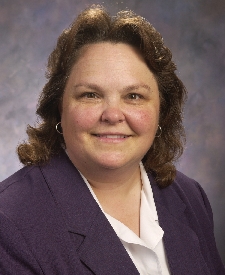Polubinsky Is Co-Author of NASPE Position Aimed to Help Athletes with Life-Saving Treatment
August 4, 2011

Renee Polubinsky, associate professor in WIU's kinesiology department, recently co-authored the NASPE's position statement, "Availability and Access to Automated External Defibrillators in Schools During Participation in Physical Activity," as a response to sudden cardiac arrest and its status as the leading cause of death among young athletes.
[Download Print-Quality Image]
MACOMB, IL -- A Western Illinois University faculty member is a contributing author to the National Association for Sport and Physical Education's new position statement aimed to help provide life-saving treatment for young athletes who may experience sudden cardiac arrest. Renee Polubinsky, associate professor in WIU's kinesiology department, recently co-authored the NASPE's position statement, "Availability and Access to Automated External Defibrillators in Schools During Participation in Physical Activity," as a response to sudden cardiac arrest and its status as the leading cause of death among young athletes.
"One in 25 to 50 high schools can expect a sudden cardiac arrest to take place on campus each year according to the New England Journal of Medicine," states a NASPE release. "Pre-athletic cardiac screening in young athletes has yet to be universally adopted, leaving automated external defibrillators [AEDs] as a vital proactive safety measure for protecting young athletes during an athletic program or physical activity setting. NASPE suggests each school's emergency action plan should include immediate access to and use of defibrillators, be accessible during all regular school hours and after school hours for sporting and extracurricular events."
In the position statement, Polubinsky -- who co-authored the statement with Don Bales (Lowell High School, Lowell, IN) -- noted that studies have found that coaches, athletic trainers and nurses are, most likely, the first responders to sudden cardiac arrest during the school day and at extracurricular activities.
"With 75 percent of all sudden cardiac arrest cases in schools occurring in relation to sporting events, it is vital that automated external defibrillators be available to coaches, athletic trainers and school medical personnel," Polubinsky said. "Knowing AEDs can save lives, it is imperative that we get the word out so schools acquire the devices and train school personnel in their use. Many times, it is not only the student-athletes at risk of sudden cardiac deaths, but spectators have also been saved by having AEDs readily available at all sites where physical activity is taking place."
NASPE's National Standards for Sport Coaches (see www.aahperd.org/naspe/standards/nationalStandards/SportCoaches.cfm) addresses this responsibility of these first responders directly, stating that coaches should "recognize injuries and provide immediate and appropriate care."
NASPE President Dennis Docheff of the University of Central Missouri noted that early and immediate use of both CPR and AEDs carry the potential to save the lives of children and young athletes.
"NASPE has developed this position statement at a crucial time, where we are seeing more and more headlines regarding young adults dying of cardiac arrest that may have been prevented with the right medical equipment, knowledge and training in place. NASPE's position statement should be utilized as a guide for policy and practice."
According to its website, the NASPE is the non-profit professional membership association that sets the standard for best practices in quality physical education and sport. "Availability and Access to Automated External Defibrillators in Schools During Participation in Physical Activity" is available on the NASPE's website (via a PDF file) at www.aahperd.org/naspe/standards/upload/Availability-Access-to-AEDs-Final-5-5-11.pdf.
For more information, contact Polubinsky at (309) 298-2050 or RL-Polubinsky@wiu.edu.
Posted By: University Communications (U-Communications@wiu.edu)
Office of University Communications & Marketing

Connect with us: